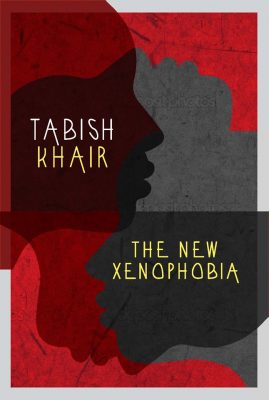Review
By
Dr. Ajay K Chaubey
Natives of any heteronormative society are often flabbergasted by seeing a stranger in their periphery of village, town or city. Largely, ours is the receptive society where every stranger is treated as atithi (guest) and greeted in our homes. However, we have isolated ourselves by being professional and self-centred in this techno-global era. Consequently, our cultural, civilizational, intellectual and psychological training is digressed and distorted and we are normally panicked by arrival of any ‘stranger’ in our society, state or nation. Simply, it is called ‘xenophobia’ in psychology and its allied areas. Though it has always been an age old phenomenon, yet to redefine the term ‘xenophobia’ is the need of hour in milieu of recurrent terror attacks across the globe (especially on non-Islamic states).
The publication of Tabish Khair’s recent feat, The New Xenophobia, has created a buzz in the media and academia not because of creative articulation but because of the subject matter of the book. This has been brought in at such a time when the European nations are under the scanner for being receptive and offensive. Germany, on one hand, sheltered millions of Syrians, was declared the ‘kindest’ nation in the world while France, on the other, became blasphemous for criticizing Mohammad Sahib by artifacts of cartoons on him in Charlie Hebdo and was attacked by the terrorists not once but twice in the previous year. The entire world, today, seems to be more ‘xenophobic.’ The move of intelligentsia (majorly leftists and anti-rightists) on ‘intolerance’ was pervasive in India; resistance of Modi’s visit by the Indian diaspora in the UK; and Donald Trump’s anti—Islamic campaign in the USA; insurgencies in the Middle East; anti-Indian move by Madhesi community in Nepal inaugurate fresh debates on racial intolerance, ethnic clashes or ‘clash of civilizations.’ In this way, Khair’s book offers fresh perspectives not only on ‘new xenophobia’ but also on ‘old xenophobia,’ racism, capitalism, and Nazism, etc.
Tabish Khair, an Indian by descent and academic pursuit and a Danish by relocation, settlement and intellectual training, must have experienced the fulcrum of ‘xenophobia’ as a Muslim reporter at the Times of India in India (as most Muslims are treated as traitors by the so-called nationalists and rightists). Such folkloric clashes are intense owing to the ‘power’ structure of one community over the other. The usage of power is not challenged but what is dissenting and defeasible is the misuse of power which Khair himself postulates in the ‘Introduction’ of the book, “[m]y quarrel is not with power, but some of its usages and inequalities” (4). The epistemic power, on one hand, is always encouraged, as it is the only tool for the advancement and the development of the underdeveloped society, community or state while the temporal power, on the other, is more ‘absolute’ than the ‘epistemic’ power. The shift of epistemic power to temporal is abstract but it is very much “embedded in material locations and physical definitions of power…and social relation,” writes Khair (5). However, putting the minor communities, Dalits, tribes or the least exposed segment of society under the watchdog galvanises xenophobia and unwarranted fear of prevailing death in them.
Sliced into six chapters, minus introduction and conclusion, the book comprehensively deals with the theoretical contours of xenophobia and covers speculative historiography of ‘strangeness’ in the very first chapter entitled ‘The Making of a Stranger.’ Khair transcripts that “anti-colonial movements”—Ghadar of 1857 in India; slave revolts in the Caribbean; Algerian war of Independence—have played a crucial role in formation of “xenophobic violence” (10). The following chapter, ‘The Changing Face of Xenophobia,’ charts paradigm shift of xenophobia by ‘induction’ of the East India Company in India, which used to “‘cut off’ the hands of Indian weavers” though the same has been contradicted by many historians (30). Khair also registers that,
“The ‘chopped hands’ actually become a metaphor for the power of imperial / colonial capitalism to render weavers ‘handless’ by restricting their opportunities and flooding the universal market with cheap mass-produced textiles by Indians to cater to the need of fashion and finance of their colonial masters…” (32, italics mine).
Thus, it is evident that colonial capitalism was the root cause of xenophobia and salience of such capitalism cannot be disavowed in the framework of immigration of ‘girmitiyas’ in the eighteenth and nineteenth century.
The next chapter, ‘Racism, Nationalism, and Nazism,’ underpins that nationalism coalesces racism and Nazism, which are “commonly associated with outbreaks of old xenophobia” (58). The locus of the chapter is that the lineage of old xenophobia is slavery, which gives birth to racism and both of them—‘slavery’ and ‘racism’—are overtly and covertly connected with capitalism. The author further traces the history of slavery through the “comedies of Aristophanes” and finds that “Slaves could be…seen in ancient Greece and Rome” (62). Today, racism has replaced slavery in the “wake of monetized economies,” which has been studied in the light of Social Darwinism. This is also contested that “Racism…is a recent creation” and the same is not much different from Nazism and nationalism (73). Khair concludes the chapter by laying an emphasis that the nexus of ‘old xenophobia’ is fear—a hidden threat—which can be perceived keeping in view of ‘physical difference,’ opines Khair:
…[t]he hooked noses of Jews and Turks, the colour of ‘Blacks’, the curry smell or effeminate gestures of East Indian, the private parts of women…trigger fear. (84)
‘Capital and New Xenophobia,’ the next chapter, highlights the conundrums of ‘new xenophobia,’ unlike old xenophobia, bred by free movement of capital and labour across the European nations (91). In this way, multiculturalism, Islamist terrorism, religious intolerance, and class tensions are an enemy in disguise. Khair perceives the Islamic dress code as ‘monster’ (106) but further argues that it (new xenophobia) “focuses on… not all Muslims but ‘religious’ Muslims” (108) which is based on consumerism of capitalism. It is, therefore, conclusive that the crux of ‘new xenophobia’ is “capital” power and “it is the capital that is globally dominant today” (110). However, the role of violence in the construction of new xenophobia can never be ruled out.
In the penultimate chapter, ‘Deceptive Violence,’ the thesis of Steven Pinker is thoroughly analysed and studied by Khair wherein it is evidently mentioned that “…there is historical and …cognitive data…[which] prove that the past was not just more violent than the present, but also that violence was systematically declined in history” (113). The rhizome of such violence, notes Pinker, was not xenophobia but neighborhood. Pinker attributes his analysis to Hobbes’ Leviathan where it is reiterated that there are three basic principles of violence—competition, fear and glory (118) which is quite common in any caste, creed and community. It is further questioned whether violence can be civilized. The author dexterously postulates, “…xenophobia has changed character over time and space, violence has changed its form and narratives too” (124; italics mine). What distinct from earlier violence to the violence of now is the way of fighting. Earlier people used to fight for overpowering their rights upon one nation to the other. One can refer to the Great Depression, World War-I, World War-II, the Cold War, the Gulf War, the US attack over Hiroshima and Nagasaki, etc. But, of late, there is fight for our right—Feminists fight against misogynists [Khair beautifully cites the example of the clash between Sylvia Plath and Philip Larkin (126)]. So, it is tangible that the epicenter of such fights is shifted from political to social to familial structures, which are ubiquitous in every society.
In the last chapter, ‘New Xenophobia and Old Xenophobia,’ it is perceived that the former is “more reliant” than the latter. The fundamental difference in these two terms has been noted by Khair in the light of Jasbir K Puar’s propositions. On one hand, old xenophobia is considered to be “anti-Semitic and homophobic” while the new xenophobia, on the other, is supposed to be “not anti-Semitic and homophobic” (141; italics original). Nevertheless, Khair, in his original, natural and astute academic fervour, differs and defers from Puar’s notion in the following way:
New xenophobia does not just replace old xenophobia globally; it exists along with it, and sometimes justifies its own kind of violence with reference to the physical and material violence of old xenophobia. (139)
In the present scenario, every third person is xenophobic. Marathis are xenophobic to Biharis and vice-versa; Asamese are intolerant to the people of northern India; Whites are xenophobic to blacks and browns. The simplest reason of such ‘xenophobia’ is power clashes. In addition, the current media also has played a crucial role in flourishing xenophobia (188). However, what can be the solution to such clashes, which harbour xenophobia? Can the theory of ‘vasudhaiva kutumbakam’ (the world is one family) be postulated and practised else, we keep on fighting. Fight for right or fight to kill or fight to die? Acceptance of constructivism and cultural plurality cannot exterminate but can curtail such “phobias” from our society.
Tabish Khair
Born and educated in a small town of Bihar, India, TABISH KHAIR is the author of various books, including the poetry collections, Where Parallel Lines Meet (Penguin, 2000) and Man of Glass (HarperCollins, 2010), the studies, Babu Fictions: Alienation in Indian English Novels (Oxford UP, 2001) and The Gothic, Postcolonialism and Otherness (Palgrave, 2010) and the novels, The Bus Stopped (Picador, 2004), Filming (Picador, 2007), The Thing About Thugs (Harpercollins, 2010; Houghton Mifflin, 2012) and How to Fight Islamist Terror from the Missionary Position (Interlink and Corsair 2014).
His honours and prizes include the All India Poetry Prize (awarded by the Poetry Society and the British Council) and honorary fellowship (for creative writing) of the Baptist University of Hong Kong. His novels have been shortlisted for nine prestigious prizes in five countries, including the Man Asian Literary Prize and the Encore Award, and translated into several languages.
Other Routes, an anthology of pre-modern travel texts by Africans and Asians, co-edited and introduced by Khair (with a foreword by Amitav Ghosh) was published by Signal Books and Indiana University Press in 2005 and 2006 respectively; he has also edited or co-edited other scholarly works.
His writing has appeared in various anthologies of poetry and fiction, including The Bloodaxe Book of Contemporary Indian Poetry, City Improbable: Writings on Delhi, The New Anthem, Fear Factor: Terror Incognito, Delhi Noir and Penguin’s 60 Indian Poets. Academic papers, reviews, essays, fiction and poems by Khair have appeared in Indian (Hindu, Times of India, Biblio: A Review of Books, Indian Book Review, Economic Times, PEN, DNA, Telegraph, Outlook etc), British (Guardian, New Left Review, Wasafiri, Third Text, Independent, New Statesman, First Post, Journal of Commonwealth Literature, Journal of Postcolonial Writing, London Magazine, P.N. Review, Salt, Metre, Thumbscrew, Stand etc), Danish (Information, Politiken, Weekendavisen etc), American, German, Italian, South African, Chinese and other publications.
Several recent books on contemporary Indian writing, including Bruce King’s ‘Rewriting India: Eight Writers’ (Oxford UP, 2014), discuss Khair’s work in detail. Two collections of essays on Khair’s poetry and fiction have also been edited and published by Om Prakash Dwivedi and Cristina M. Gámez-Fernández.
Khair now mostly lives in a village off the town of Aarhus, Denmark.




No Comments Yet!
You can be first to comment this post!